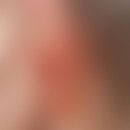Synonym(s)
DefinitionThis section has been translated automatically.
Cutis laxa is the name given to a heterogeneous group of hereditary diseases whose main symptom is a pendulous, inelastic (in contrast to Marfan's syndrome and Ehlers-Danlos syndrome) skin. These cutaneous characteristics are almost always due to loss, fragmentation or severe disorganisation of the elastic fibres. The systemic significance of this disorder of elastogenesis affects different organ systems. Apart from the skin, lungs, vessels and also joints are mainly affected. The hereditary forms of Cutis laxa are triggered by mutations in different genes (e.g. PYCR1, LTBP4, ATP6V0A2 and others), which are functionally involved in the build-up or breakdown or in the organisation of elastic fibres. In principle, autosomal dominant forms can be distinguished from autosomal recessive forms, independent of the gene systematics. If the clinical phenomenon "cutis laxa" or rather "cutis laxa-like skin changes" is considered in terms of differential diagnosis, further hereditary as well as acquired clinical pictures have to be taken into account.
ClinicThis section has been translated automatically.
The clinical spectrum of autosomal recessive cutis laxa is very heterogeneous with respect to organ involvement and severity. Autosomal recessive cutis laxa type 3B (ARCL3B), also known as "PYCR1-related progeroid syndrome", is caused by mutations in the PYCR1 gene (gene location: 17q25.3) (Reversade B et al. 2009). The gene PYCR1 (pyrroline-5-carboylate reductase) encodes a pyrroline-5-carboxylate reductase. In lesional tissue fibroblasts, an altered mitochondrial morphology and an increased rate of apoptosis could be demonstrated (Reversade B et al. 2009).
Clinically, this mutation leads to a progeroid cutis laxa with developmental disorders, but not to emphysema formation. Lin et al (2011) identified a patient with ARCL3B gene defect from a non-consanguine Chinese family. Noticeable were a broad fontanel, a protruding forehead, fine and sparse hair, spread eyebrows, sunken eyes, small palpebral fissures, hypertelorism, a flat nose with hypoplastic nostrils, thin lips and dysplastic, large helices. The skin was thin, wrinkled and translucent and showed superficial veins. There were also skeletal anomalies: osteoporosis, flexion contractures of the upper limbs, and flat feet, luxation of the hip joints and an increased tendency to fracture. Also inguinal hernias, congenital glaucoma and blue sclerae, hypertrophic pyloric stenosis and mental retardation with significant speech delay.
LiteratureThis section has been translated automatically.
- Adams E et al (1960) Hydroxyproline metabolism. III. enzymatic synthesis of hydroxyproline from delta1-pyrroline-3-hydroxy-5-carboxylates J Biol Chem 235: 3499-3503.
- Lin DS et al (2011) Compound heterozygous mutations in PYCR1 further expand the phenotypic spectrum of de Barsy syndrome. Am. J. Med. Genet. 155A: 3095-3099.
- Lin DS et al (2011) Compound heterozygous mutations in PYCR1 further expand the phenotypic spectrum of de Barsy syndrome. Am J Med Genet 155A: 3095-3099
- Panza E et al (2016) ALDH18A1 gene mutations cause dominant spastic paraplegia SPG9: loss of function effect and plausibility of a dominant negative mechanism. (Letter)Brain 139: e3
- Reversade B et al (2009) Mutations in PYCR1 cause cutis laxa with progeroid features. Nat Genet 41:1016-1021.
Outgoing links (1)
Pycr1 gene;Disclaimer
Please ask your physician for a reliable diagnosis. This website is only meant as a reference.



